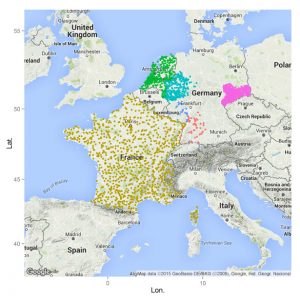In this post, Verena Schreiner talks about her paper “Pesticide mixtures in streams of several European countries and the USA”.
A vast number of different pesticides are typically used in agriculture. Consequently, pesticides often occur as mixtures in streams. The aim of our study lay in identifying the most frequently occurring pesticide mixtures and possible drivers of their size.

Established monitoring points in Europe (graphic by V. Schreiner)
In this study, we analysed routine monitoring data based on grab water samples from the USA, France, the Netherlands and Germany from more than 4500 sites and ~56,000 sampling occasions. We identified most frequently detected pesticide mixtures and possible drivers of their composition and size. For example, we analysed whether the size of mixtures might be explained by the size of the upstream catchment area, the ratio of agricultural land use within the upstream catchment and the number of analysed pesticides. We thereby were able to observe, that especially the number of analysed pesticides influences the size of mixtures, while the size of the upstream catchment area does not. Additionally, we observed that the Limit of Quantification during analysis is a crucial factor of varying detection rates in the different countries. Furthermore, the study provides priority mixtures and single compounds from the analysed countries, which may be used for future ecotoxicological studies to improve risk assessment for stream ecosystems.
The paper was authored by Verena C. Schreiner, Eduard Szöcs, Avit Kumar Bhowmik, Martina G. Vijver, and Ralf B. Schäfer and is published in Science of the Total Environment.
